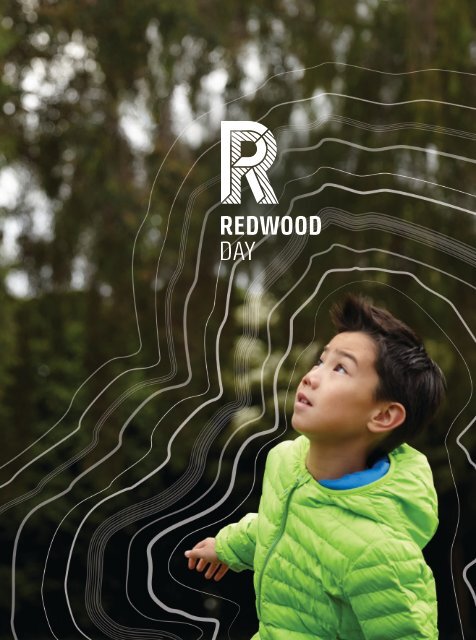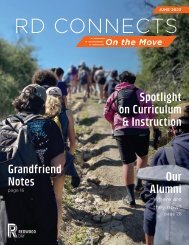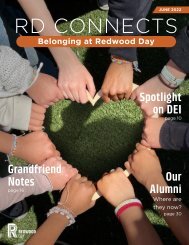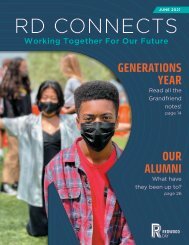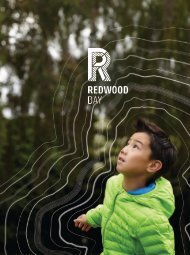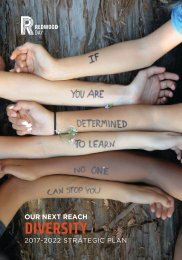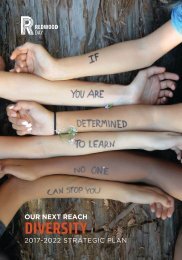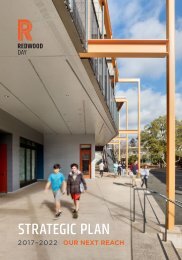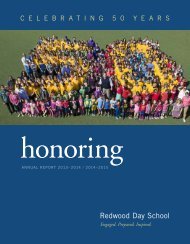2016-2017 RD Viewbook for website
Create successful ePaper yourself
Turn your PDF publications into a flip-book with our unique Google optimized e-Paper software.
2
GROW<br />
INTO GREAT<br />
Challenge is not one-size-fits-all. But when<br />
you find that fit, incredible things happen.<br />
At Redwood Day we set the bar high<br />
<strong>for</strong> everyone, but tailor challenge to the<br />
individual.<br />
That’s what inspires our students<br />
to grow beyond good enough —<br />
and grow into great.<br />
In the classroom.<br />
On the playground.<br />
Into the future.<br />
1<br />
1
INSPIRED<br />
MINDS WANT<br />
TO GROW<br />
Our curriculum is benchmarked against<br />
the highest standards of academic<br />
excellence. We challenge students in ways<br />
that uniquely suit them and provide the<br />
support they need to succeed.<br />
2 3
ACADEMICS<br />
“At Redwood Day, I had unique experiences<br />
I couldn’t have had anywhere else.”<br />
Redwood Day 8th Grade Student<br />
MATH<br />
READING<br />
Redwood Day’s math program — Math in Focus:<br />
Instruction takes place in classrooms, in fully outfitted<br />
Our reading curriculum begins with phonemic<br />
As students move through the program, reading <strong>for</strong><br />
Singapore Math — and instruction are designed to<br />
labs, and in the outside world. In these settings,<br />
awareness and reading comprehension. We encourage<br />
understanding and comprehension becomes central<br />
create strong and nimble mathematicians. Teachers<br />
students learn concrete facts, ask lots of questions,<br />
students to read what interests them in addition<br />
to instruction and practice. From literacy centers and<br />
support individual growth as students move from<br />
test these questions, grapple with unexpected<br />
to our structured curricular materials. And since<br />
classroom book clubs to research projects, library<br />
concrete concepts to the pictorial to the abstract<br />
outcomes, and pursue a variety of possible answers.<br />
early elementary reading abilities change quickly,<br />
class, and comparative literature, students learn to<br />
at each grade level. Assessments measure each<br />
For example: students collect water samples to<br />
we per<strong>for</strong>m continual summative and <strong>for</strong>mative<br />
read <strong>for</strong> knowledge, understanding, and the sheer<br />
student’s knowledge (content), comprehension<br />
examine the life and toxins contained within them;<br />
assessments to make sure each child is ideally<br />
joy of it. They become confident readers who find<br />
(deeper, process-oriented understanding), and<br />
they observe and track the effects of drought on soil;<br />
challenged and supported to take her next reach.<br />
connections within texts, draw in<strong>for</strong>mation from a<br />
variation (tackling problems that require students<br />
they examine the impact of exercise on the human<br />
variety of sources, love to escape into the landscape<br />
to apply learned skills and strategies in a new way).<br />
respiratory system; they create and market products<br />
of a book, and enthusiastically meet the challenge of<br />
Differentiation underpins the math curriculum. Each<br />
student is challenged to stretch her understanding<br />
and skills as she uses complex and nuanced problemsolving<br />
with each new concept. Throughout the K-8<br />
program, students work individually, in small groups,<br />
and as class learning communities on algorithms,<br />
that address environmental needs; and they design<br />
and build simple machines. Additionally, students<br />
experiment with chemical reactions, observe plant and<br />
animal biology, and monitor air and soil quality. Our<br />
science classes promote inquiry, research, observation,<br />
investigation, and innovation.<br />
exploring a new writer or genre.<br />
word problems, and interdisciplinary projects (such<br />
as using math to address social and world problems).<br />
Redwood Day students learn, stretch, and apply<br />
math every day.<br />
SCIENCE<br />
Children become scientists early at Redwood Day.<br />
Beginning in kindergarten, students learn the<br />
intrinsic value of asking questions and <strong>for</strong>ming<br />
hypotheses. As they grow, students delve deeply<br />
into biology, chemistry, geology, physics, and<br />
environmental science.<br />
4<br />
5
WRITING<br />
Our writing curriculum — Lucy Calkins’ Units of<br />
Study <strong>for</strong> Teaching Writing, from the Teachers<br />
College at Columbia University — sets students up<br />
to live, work, and learn as writers. Using this model,<br />
students internalize writing as a process, and grow<br />
com<strong>for</strong>table with preparing multiple drafts, editing,<br />
and revising. This builds our students’ writing fluency<br />
and challenges them to move past potential barriers<br />
in written expression by identifying writing strategies<br />
that work best <strong>for</strong> them.<br />
SOCIAL STUDIES /<br />
HISTORY<br />
Our social studies curriculum engages students with<br />
world, national, state, and local history. Students<br />
grow to understand the historical, political, economic,<br />
and religious connections that are woven throughout<br />
history. As they progress through the program,<br />
students cultivate an increasingly sophisticated<br />
framework <strong>for</strong> thinking about social and historical<br />
events, places, and people. Meanwhile, we continually<br />
examine history through the lenses of social justice,<br />
All students complete in-depth research projects, read<br />
texts, prepare and practice debate, and participate in<br />
interactive projects that engage and inspire reflection<br />
on how context in<strong>for</strong>ms history. Meanwhile, they<br />
learn to make interdisciplinary connections between<br />
history and literature, art, math, science, and music.<br />
INNOVATION AND<br />
DESIGN<br />
Principles of innovation and design are built into<br />
every grade level. Students use our Innovation and<br />
Design Studio to explore ideas or concepts that<br />
tie into their current areas of study. For example,<br />
students can ideate, design, and build as a way of<br />
extending their understanding of electricity and<br />
simple circuits. Similarly, they can build geometric<br />
structures using basic 2-D shapes from their math<br />
studies to explore the creation of 3-D shapes.<br />
Through mini-lessons, teachers use mentor texts<br />
and questioning to engage students in strategic and<br />
reflective discussions about how to strengthen their<br />
writing. Teachers become writing coaches, offering<br />
tailored, focused mentoring and feedback through<br />
individual and small group sessions.<br />
Students write narrative, in<strong>for</strong>mational, and<br />
opinion pieces from kindergarten through 8th<br />
grade. These can take the <strong>for</strong>m of research papers,<br />
letters, restaurant reviews, science project reports,<br />
persuasive essays, literary analysis, and more. Our<br />
service learning, and diverse perspectives.<br />
Our K-8 curriculum starts by learning about families<br />
as well as local and regional communities. From there,<br />
students undertake a historical and geographical<br />
investigation of Cali<strong>for</strong>nia, an examination of our<br />
nation’s history, and, finally, an extensive study of<br />
global history. Along the way, students study culture,<br />
ancient world history and civilizations, religion,<br />
the rise and fall of great empires, early political<br />
structures, imperialism, colonialism, U.S. history,<br />
world wars, and current events.<br />
In grades 6-8, Design, Innovation, and Technology is<br />
a required course that intersects with core academic<br />
subjects. The 6-8 curriculum includes a three-year<br />
cycle during which students learn and apply<br />
design thinking principles. They use these tools to<br />
design and fabricate solutions <strong>for</strong> social and physical<br />
problems. Content areas include thought processes,<br />
drafting by hand, computer-aided design (CAD),<br />
computer programming, and the use of hand tools as<br />
well as digital fabrication tools such as 3-D printers<br />
and computer-driven cutters.<br />
K-8 program grows strong writers with an extensive<br />
toolbox of skills, a deep understanding of grammar<br />
rules and writing mechanics, and the ability to pull<br />
from a variety of genres.<br />
6 7
CURRICULUM<br />
Grade Language Arts Social Studies / History Math<br />
Science Spanish<br />
K<br />
Differentiated center instruction in<br />
sounds, guided reading, reading<br />
School community, family, holidays<br />
and cultural traditions, Oakland<br />
Number sense, patterns, the<br />
calendar, measurement, estimation,<br />
Life cycles, the five senses, trees/<br />
wood/paper, animals<br />
Exposure to vocabulary through<br />
movement, stories, games, drama,<br />
comprehension, writer’s workshop<br />
community<br />
addition, subtraction, shapes,<br />
songs, and comprehension<br />
number facts<br />
warm-up routines<br />
1 st<br />
Phonetic awareness, comprehension,<br />
writing mechanics, grammar, guided<br />
Families, cultures, continents,<br />
classroom and world communities,<br />
Number sense, place value,<br />
operations, addition, subtraction,<br />
Sound and light, air and weather,<br />
insects, the rain<strong>for</strong>est, penguins,<br />
Simple grammar patterns through<br />
movement, stories, and games;<br />
reading, story mapping, word<br />
individual heritage<br />
graphing, geometry, patterns,<br />
spiders<br />
verbal questions and responses;<br />
families, spelling, poetry, narrative<br />
comparisons, time and money,<br />
introduction to reading<br />
and in<strong>for</strong>mation writing, penmanship<br />
multiplication and division through<br />
grouping<br />
2 nd<br />
Reading, personal narrative,<br />
research paper, opinion letters,<br />
Local community, citizenship,<br />
maps, heroes, cultures and<br />
Measurement, number sense,<br />
multiplication, division, fractions,<br />
Pebbles, sand and silt, solids and<br />
liquids, oceans, botany<br />
Deeper vocabulary through<br />
movement, stories, and games;<br />
in<strong>for</strong>mation writing, grammar,<br />
traditions, biographies<br />
geometry, mental math, rounding<br />
listening; reading mini-stories;<br />
paragraphs, peer review, editing,<br />
numbers<br />
speaking complete sentences;<br />
poetry, spelling<br />
beginning writing<br />
3 rd<br />
Personal narrative, in<strong>for</strong>mation<br />
writing, opinion writing, persuasive<br />
Oakland history, including studying<br />
the Ohlone peoples; collecting<br />
Addition and subtraction up to<br />
10,000, multiplication and division<br />
Simple machines, water and<br />
climate, structures of life, magnets<br />
More complex verbal responses;<br />
expanded vocabulary through<br />
essays, reading comprehension,<br />
oral histories from families and the<br />
facts and algorithms, two-step word<br />
movement, games, listening,<br />
literature discussion skills, spelling<br />
greater Oakland community<br />
problems using all four operations,<br />
songs, and independent reading;<br />
rules, cursive<br />
comparing fractions, studying shapes<br />
increased writing exercises<br />
and angles through comparisons and<br />
classifications<br />
Literature circles, book reports,<br />
Cali<strong>for</strong>nia history and geography:<br />
Data and probability, fractions,<br />
4 th 9<br />
Ecosystems, wetland habitats,<br />
Introduction to short Spanish<br />
in<strong>for</strong>mation writing and research,<br />
Native Cali<strong>for</strong>nian experiences,<br />
number sense through millions<br />
geographical <strong>for</strong>mations, rocks and<br />
novels, exposure to past tense,<br />
persuasive essays, poetry,<br />
Cali<strong>for</strong>nia explorers, missions,<br />
place, multi-digit multiplication<br />
minerals, electricity, circuits, health,<br />
building vocabulary of nouns and<br />
grammar, vocabulary, fluency,<br />
ranchos, and the Gold Rush<br />
and division, geometry, algebra,<br />
nutrition<br />
present-tense verbs, increased<br />
reading comprehension<br />
functions, decimals<br />
written and verbal responses<br />
8
CURRICULUM<br />
Grade Language Arts Social Studies / History Math<br />
Science Spanish<br />
5 th<br />
Strategies <strong>for</strong> generating writing<br />
topics, narrative writing, persuasive<br />
U.S. history from English<br />
settlements to colonization,<br />
Advanced multiplication and<br />
division, fractions and mixed<br />
Chemistry, weather on Earth, the<br />
solar system, the scientific method,<br />
Reading stories and a short novel,<br />
responses to verbal and written<br />
writing, written and oral responses<br />
Declaration of Independence and<br />
numbers, conversion of fractions<br />
microscopes, biology, human<br />
questions in both present and past<br />
to texts, editing, revising, assigned<br />
the American Revolution, colonies<br />
to decimals and percents, algebra,<br />
anatomy, nutrition<br />
tenses, <strong>for</strong>mal study of regular verb<br />
and self-selected reading<br />
to a country, <strong>for</strong>ming the U.S.<br />
area of a triangle, ratios, graphs<br />
conjugation, drama, technology,<br />
Constitution, three branches of U.S.<br />
and probability, angles, surface<br />
group projects<br />
government, westward expansion<br />
area and volume<br />
in the 19th century and the impact<br />
on Native Americans<br />
6 th<br />
Modern and ancient literature,<br />
creation myths, personal narratives,<br />
Ancient civilizations: Mesopotamia,<br />
Egypt, China, India, Hebrews and<br />
Number sense and operations,<br />
fractions, decimals, percents,<br />
Earth and environmental sciences:<br />
density, pressure, temperature,<br />
Transition to Spanish immersion;<br />
grammar, vocabulary, reading,<br />
expository writing, vocabulary,<br />
Greeks; cultural universals<br />
ratios, algebra, prime factorization,<br />
altitude, and plate tectonics;<br />
and writing; Spanish and Latin<br />
grammar<br />
geometry<br />
environmental studies: pollution,<br />
American culture<br />
climate, and human impact on the<br />
environment<br />
7 th<br />
World literature, American fiction,<br />
poetry, elements of literature,<br />
World history, religions, and<br />
cultures: Europe, Asia,<br />
Integrated algebra, proportions<br />
and problem-solving, number<br />
Life science: cells, genetics, human<br />
biology, ecology, human body<br />
Vocabulary; grammar; and written,<br />
oral, and multimedia presentations<br />
analytical essay writing, vocabulary,<br />
West Africa, India, Middle East,<br />
sense, geometry, percents,<br />
systems, and evolutionary theory<br />
grammar<br />
and the Americas<br />
probability<br />
Themes of individual vs. group<br />
U.S. history from colonization<br />
Algebraic expressions, linear<br />
Physical science: chemistry, <strong>for</strong>ce<br />
Vocabulary; present and past<br />
identity, identity <strong>for</strong>mation, social<br />
through the Vietnam War:<br />
equations, polynomials, exponential<br />
and motion, Newtonian mechanics,<br />
tenses; written, oral, and<br />
justice, self-selected and assigned<br />
government, politics, and the<br />
8 th 11<br />
growth and decay, systems,<br />
simple machines, energy, and<br />
multimedia presentations;<br />
novels, literary analysis, writing<br />
human experience<br />
algebraic word problems, quadratic<br />
evolution<br />
readiness <strong>for</strong> high school<br />
monologues, vocabulary, grammar<br />
equations<br />
Spanish II<br />
10
WHERE EQ<br />
MEETS IQ<br />
We believe social and emotional<br />
smarts are just as important as<br />
academic learning. We teach<br />
students to work through their<br />
conflicts, to dust themselves off if<br />
they stumble, and to respect and<br />
value our differences. And in<br />
a warm, supportive environment,<br />
they cultivate the courage they<br />
need to face any challenge.<br />
12<br />
13
REDWOOD DAY LIFE<br />
“I want to thank my class <strong>for</strong> always being<br />
authentic, energetic, compassionate, and just<br />
being yourselves.”<br />
Redwood Day 8th Grade Student<br />
DIVERSITY, EQUITY,<br />
AND INCLUSION<br />
At Redwood Day, diversity is about each of us and<br />
all of us. It’s at the core of our community and<br />
curriculum, encompassing everything from race,<br />
gender, and sexual orientation, to economic<br />
background, family structure, religion, physical<br />
ability, academic strengths and challenges,<br />
academic interests, temperament, social approach,<br />
and more. We know that students learn best when<br />
they’re seen <strong>for</strong> who they are, feel connected to<br />
peers and teachers with shared aspects of identity,<br />
and are stretched to consider identities, beliefs,<br />
abilities, approaches, and worldviews that differ<br />
from their own.<br />
Close to half of our students identify as being<br />
students of color, and close to half identify as being<br />
white. Our community includes families with a wide<br />
variety of economic experiences and is made up<br />
of LGBTQ, heterosexual, adoptive, and biological<br />
families as well as families with single or multiple<br />
households or parents.<br />
Equity and inclusion work is core to our school<br />
values, and essential to the development of healthy,<br />
happy children who will thrive as adults. Children<br />
who know who they are will be better prepared<br />
to navigate the world. To that end, every student<br />
at Redwood Day is part of an equity and inclusion<br />
or affinity group that explores a range of topics.<br />
Topics are in<strong>for</strong>med by student identity and interest,<br />
and age-leveled groups are led by faculty and<br />
administrators who have been trained as facilitators.<br />
These groups provide spaces where students can<br />
connect with others who self-identify a shared<br />
similarity or as “alike.” This experience allows<br />
students to develop a strong sense of who they are,<br />
and also lets them practice thinking and talking<br />
openly about identity, stereotypes, privilege,<br />
assumptions, and equity.<br />
SERVICE LEARNING<br />
Our service learning program connects with<br />
important curricular themes at each grade level. This<br />
way, beyond dedicated service learning projects,<br />
service learning is woven into class work, writing,<br />
math, and field trips throughout the year.<br />
An integrated approach to service learning<br />
gives students a unique opportunity to see how<br />
they connect to our local, national, and global<br />
communities. Whether students study hunger<br />
and make sandwiches <strong>for</strong> those without enough<br />
food, study local watersheds and participate in<br />
creek and lake cleanup programs, study resource<br />
inequality and collect books and art supplies <strong>for</strong><br />
other children, examine food justice and participate<br />
in community gardens and growing produce <strong>for</strong><br />
Oakland neighborhood stores, or study firsthand<br />
accounts of history by creating oral history projects<br />
with local senior citizens, our service learning<br />
projects open students’ eyes to the world around<br />
them. They learn that it’s not about standing on<br />
the outside and trying to help. It’s about being an<br />
active part of their community, seeing that what<br />
they give and what they gain are equally valuable.<br />
14<br />
15
OUTDOOR EDUCATION AFTER-SCHOOL PROGRAM “You’re never going to be alone<br />
at Redwood Day.”<br />
Outdoor education takes students outside of the Community, learning, and fun extend well beyond the<br />
familiarity of the classroom and encourages them school day through our vibrant after-school program.<br />
to stretch, support their classmates, and learn<br />
This program is offered until 6 p.m. daily and is<br />
beyond school walls. Our outdoor education trips attended by one-third to half of our students on any<br />
incorporate science-focused curricula, team-building given day.<br />
activities, discussions about conservation, and<br />
Our small student-to-staff ratio (12:1) allows us<br />
learning that leads to self-discovery and personal<br />
to provide a program that fits each child and<br />
growth.<br />
incorporates both structured activities and free play.<br />
Outdoor education trips begin in 4 th grade and are Our staff are a diverse group of energetic educators,<br />
included in the cost of tuition. Trips are organized dedicated to providing students with a fun, safe<br />
as follows:<br />
experience. Our program has a high staff retention<br />
rate, which helps us get to know each child and build<br />
• Fourth grade visits Pigeon Point (Monterey Bay)<br />
a relationship with the entire family, year after year.<br />
<strong>for</strong> a two-night trip, chaperoned by parents and<br />
teachers.<br />
In addition to our regular extended care program,<br />
we offer enrichment classes throughout the week<br />
• Fifth grade visits Exploring New Horizons Outdoor<br />
(two 12-week sessions take place each year). These<br />
School (Loma Mar) <strong>for</strong> a four-night trip, chaperoned<br />
classes provide opportunities <strong>for</strong> students to explore<br />
by teachers and mentored by naturalists.<br />
interests and talents beyond the curriculum. Past<br />
• Sixth grade visits Pinnacles National Park <strong>for</strong><br />
classes include Circus Arts, Minecraft, 3-D Printing,<br />
a week of camping, hiking, rock climbing, team- Carpentry, Hip-Hop Dancing, Girls Club, Spanish,<br />
building, and learning. They are chaperoned by the West African Drumming, Mandarin, Basketball,<br />
6 th grade advisory team.<br />
Cartooning, Kung Fu, and more.<br />
• Seventh grade spends a week in the Santa Cruz<br />
mountains, where they stay in cabins, hike, play<br />
games, participate in ropes courses, ocean kayak,<br />
work at a farm and explore food justice, and visit<br />
tide pools. They are chaperoned by the 7 th<br />
grade advisory team.<br />
• Eighth grade spends a week on Catalina Island,<br />
where they stay in cabins, snorkel (day and night!),<br />
farm, hike, participate in a ropes course, and much<br />
more. They are chaperoned by the 8 th grade<br />
advisory team.<br />
Redwood Day Alumna<br />
ATHLETICS<br />
Our athletics program connects sports to the social, Winter<br />
emotional, and physical well-being of student<br />
• Boys and Girls Basketball (JV and Varsity)<br />
athletes. About 75% of Middle School students<br />
participate in our athletics program each year. The Spring (Co-Ed)<br />
program draws students at many different levels • Track and Field<br />
of experience. Our coaches emphasize values of • Ultimate Frisbee<br />
commitment, integrity, self-discipline, sportsmanship, • Volleyball (JV and Varsity)<br />
and teamwork.<br />
Our program has several goals designed to<br />
Redwood Day participates in a sports league that meet the developmental needs of Middle School<br />
includes 15 middle schools from across the East Bay students:<br />
and offers the following sports:<br />
• To provide a safe, physical outlet <strong>for</strong> students to<br />
Fall (Co-Ed)<br />
find joy in expressing themselves athletically<br />
• Cross Country<br />
• Flag Football<br />
• To develop and improve athletic skills and abilities<br />
• Soccer<br />
• To provide a level of athletic competitiveness<br />
that is developmentally healthy<br />
• To instill a love <strong>for</strong> the game<br />
16<br />
17
THE ARTS<br />
Studio art classes (K-8) emphasize exploration,<br />
technique, design principles, and creative expression<br />
through a variety of media. Through learning about<br />
specific artists and artistic movements, students<br />
are given a global perspective of art. They’re also<br />
given the chance to work in a wide variety of<br />
artistic media, including drawing, watercolor, acrylic<br />
painting, sculpture, sewing, weaving, ceramics,<br />
stone-carving, printmaking, and collage. Meanwhile,<br />
classes across all grade levels work together on<br />
interdisciplinary projects that complement subjects<br />
explored in the core curriculum. And in spring, the<br />
Redwood Day Gallery trans<strong>for</strong>ms into a showcase of<br />
student art from the entire school year.<br />
Music class is a part of each child’s K-8 experience. All<br />
students learn the basic elements of music: rhythm,<br />
pitch, melody, harmony, tempo, timbre, dynamics,<br />
<strong>for</strong>m, and style. These elements are explored through<br />
a variety of learning experiences, including singing,<br />
playing instruments, dancing, games, and listening<br />
exercises as well as the study of music theory and<br />
history. In the Middle School, students all learn to play<br />
the ukulele and write and record their own music.<br />
Additionally, students can choose to participate in<br />
ensembles outside of music classes, such as chorus,<br />
rock band, strings, and jazz ensemble. In their time at<br />
Redwood Day, students gain a strong foundation of<br />
music fundamentals as well as many opportunities to<br />
expand their musical experiences.<br />
Beginning in kindergarten, each student has<br />
countless opportunities to per<strong>for</strong>m — in class,<br />
during assemblies, and at gatherings. Each year<br />
we also stage a 4th- and 5th-grade musical, a set<br />
of 6th-grade one-act plays, a Middle School play,<br />
and a Middle School musical. Students not only<br />
participate on stage, but also in production roles,<br />
including everything from lighting and sound to stage<br />
management and costume design. Middle School<br />
students participate in drama class <strong>for</strong> one trimester<br />
out of each year. There, they learn about acting<br />
and theater, character development, storytelling,<br />
improvisation, Shakespeare, script-writing,<br />
per<strong>for</strong>mance preparation, and stage direction.<br />
“Redwood Day isn’t just a school — it’s a<br />
community of genuinely caring families,<br />
teachers, and administrators.”<br />
Redwood Day Parent<br />
Specialist classes that all<br />
students participate in:<br />
• Art (K-8)<br />
• Computers (K-5)<br />
• Cooking (K-8)<br />
• Design, Innovation, and Technology<br />
(Integrated K-8 and Trimester class 6-8)<br />
• Drama (6-8)<br />
• Garden (K-5)<br />
• Health (6-8)<br />
• Library (K-5)<br />
• Music (K-8)<br />
• Physical Education (K-8)<br />
• Science (Specialist K-5, Core class 6-8)<br />
• Spanish (Specialist K-5, Core class 6-8)<br />
Hands-On Learning<br />
8th grade students using hand tools <strong>for</strong> carpentry<br />
18<br />
19
Outdoor Education<br />
8th grade students hiking on Catalina Island<br />
Garden Class<br />
2nd grade students learning outdoors in the Lower School Garden<br />
20<br />
21
READY FOR<br />
EVERYTHING<br />
Students leave Redwood Day<br />
prepared to thrive in a diverse<br />
and complex world. They have the<br />
academic and emotional smarts<br />
needed to navigate any obstacle.<br />
They have the drive to continue<br />
challenging themselves and growing<br />
as individuals.<br />
22 23
“Redwood Day gave me a really good<br />
education, and it also allowed me to make<br />
decisions about my education.”<br />
Teju Adisa-Farrar, Class of 2005<br />
Globalist, Urbanist, and Creative Director, World Unwrapped<br />
“Redwood Day helped me become a<br />
leader… It was a recognition in 7th grade<br />
of a quiet leadership that I didn’t see in<br />
myself be<strong>for</strong>e then.”<br />
Erin Erickson, Class of 2008<br />
Student Athlete and Journalist<br />
TEJU’S STORY<br />
Teju attended Redwood Day from 1st through<br />
8th grade. She knew early on that she was<br />
interested in people and is grateful <strong>for</strong> the way her<br />
Redwood Day education connected to her passions<br />
without her ever feeling isolated from those with<br />
different interests. Teju remembers the community<br />
feel of her 5th grade class, playing in the redwood<br />
trees as a young child, being supported by her 8th<br />
grade history teacher to research and write a detailed<br />
paper about South African apartheid, and the<br />
inclusive curriculum throughout the grade levels.<br />
Teju attended Wesleyan University and spent one of<br />
her four years studying in Ireland. After graduation,<br />
Teju worked in the technology sector but kept<br />
coming back to themes of community development.<br />
Today, Teju is a fellow in the 4Cities Euromaster<br />
program, a selective European Union masters<br />
program in urban studies. The program includes<br />
semesters in Brussels, Copenhagen, Vienna, and<br />
Madrid and connects closely to Teju’s own strategic<br />
consulting company, World Unwrapped, which<br />
focuses on the community pieces of urban<br />
development. When she is not studying<br />
and consulting, Teju loves poetry and writing,<br />
and has published work. Next <strong>for</strong> Teju? She<br />
will be expanding her company, learning, and<br />
helping places and people grow.<br />
ERIN’S STORY<br />
Erin came to Redwood Day in kindergarten and, since<br />
she was little, knew she wanted to become a sports<br />
broadcaster. Besides campus (the trees and the<br />
community gathering space), a favorite memory is<br />
of her 5th grade teacher, who, seeing that she was<br />
struggling with some writing concepts, had Erin<br />
gradually create a newspaper, one article at a time,<br />
each elaborating more and more on details. It was<br />
that experience that solidified Erin’s goal to combine<br />
her love of sports with writing and study sports<br />
journalism.<br />
Today, Erin is a journalism and mass communications<br />
major and plays softball at the University of Iowa.<br />
Both of these were dreams of hers since be<strong>for</strong>e she<br />
graduated from Redwood Day. Erin is working hard,<br />
taking every sportswriting job she can, and reaching<br />
<strong>for</strong> her next goal of becoming an ESPN broadcaster.<br />
24<br />
25
“Redwood Day absolutely influenced<br />
the person I am today. The supportive,<br />
aspirational environment helped me believe<br />
anything is possible, which is the core<br />
characteristic of any entrepreneur.”<br />
Robert Reffkin, Class of 1993<br />
Founder and CEO, Compass<br />
ROBERT’S STORY<br />
Robert credits his relationships with his classmates<br />
and teachers at Redwood Day with instilling in him<br />
the value of collaboration and community. He had<br />
close friendships and remembers one particular<br />
teacher who believed in him deeply and taught<br />
Robert to believe in himself. He enjoyed math from<br />
early on and confidently navigated equations and<br />
problems in his Redwood Day math classes.<br />
Robert went on to receive dual undergraduate<br />
degrees (economics and philosophy) and his MBA<br />
from Columbia University, working in finance in<br />
between his undergrad and master’s. In 2013, he<br />
founded Compass, a technology-powered real estate<br />
brokerage plat<strong>for</strong>m based in New York City. Even<br />
more important to him than being CEO of this<br />
fast-growing company that is now servicing eight<br />
major markets are Robert’s wife and two young<br />
daughters, who are the highlight of his life. In<br />
addition to his work and family, Robert has<br />
completed 50 marathons, one in each state, to raise<br />
money <strong>for</strong> charity, and even started a running club<br />
at Compass. Robert has pivoted several times in his<br />
career path, taking risks that ultimately led to his<br />
creation of a company with a strong vision, a team of<br />
talented people dedicated to a common goal, a great<br />
company culture, and a commitment to growth.<br />
26<br />
27
GROW WITH US<br />
28<br />
29
1


